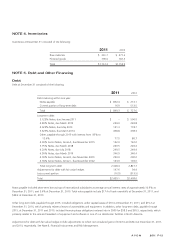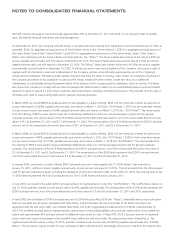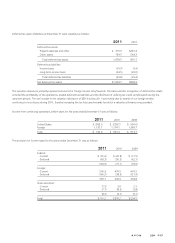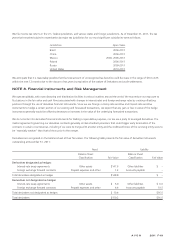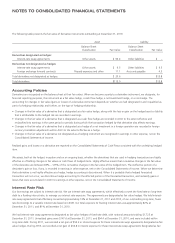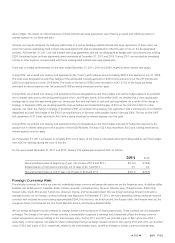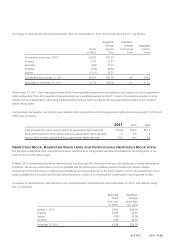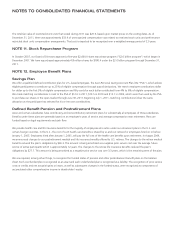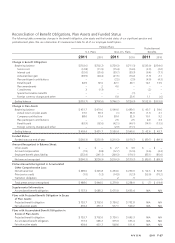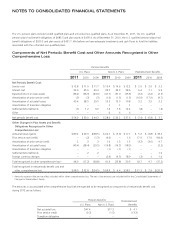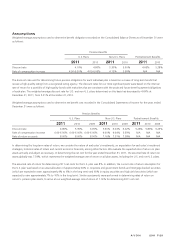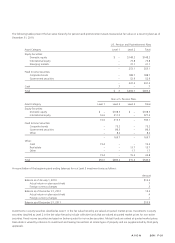Avon 2011 Annual Report Download - page 81
Download and view the complete annual report
Please find page 81 of the 2011 Avon annual report below. You can navigate through the pages in the report by either clicking on the pages listed below, or by using the keyword search tool below to find specific information within the annual report.
value hedges. The impact on interest expense of these interest-rate swap agreements was offset by an equal and offsetting impact in
interest expense on our fixed-rate debt.
At times, we may de-designate the hedging relationship of a receive-fixed/pay-variable interest-rate swap agreement. In these cases, we
enter into receive-variable/pay-fixed interest-rate swap agreements that are designated to offset the gain or loss on the de-designated
contract. At December 31, 2011, we had interest-rate swap agreements that are not designated as hedges with notional amounts totaling
$250. Unrealized losses on these agreements were immaterial at December 31, 2011 and 2010. During 2011, we recorded an immaterial
net loss in other expense, net associated with these undesignated interest-rate swap agreements.
There was no hedge ineffectiveness for the years ended December 31, 2011, 2010 and 2009, related to these interest rate swaps.
During 2007, we entered into treasury lock agreements (the “locks”) with notional amounts totaling $500.0 that expired on July 31, 2008.
The locks were designated as cash flow hedges of the anticipated interest payments on $250.0 principal amount of the 2013 Notes and
$250.0 principal amount of the 2018 Notes. The losses on the locks of $38.0 were recorded in AOCI. $19.2 of the losses are being
amortized to interest expense over five years and $18.8 are being amortized over ten years.
During 2005, we entered into treasury lock agreements that we designated as cash flow hedges and used to hedge exposure to a possible
rise in interest rates prior to the anticipated issuance of ten- and 30-year bonds. In December 2005, we decided that a more appropriate
strategy was to issue five-year bonds given our strong cash flow and high level of cash and cash equivalents. As a result of the change in
strategy, in December 2005, we de-designated the locks as hedges and reclassified the gain of $2.5 on the locks from AOCI to other
expense, net. Upon the change in strategy in December 2005, we entered into a treasury lock agreement with a notional amount of $250.0
designated as a cash flow hedge of the $500.0 principal amount of five-year notes payable issued in January 2006. The loss on the 2005
lock agreement of $1.9 was recorded in AOCI and is being amortized to interest expense over five years.
During 2003, we entered into treasury lock agreements that we designated as cash flow hedges and used to hedge the exposure to the
possible rise in interest rates prior to the issuance of the 4.625% Notes. The loss of $2.6 was recorded in AOCI and is being amortized to
interest expense over ten years.
As of December 31, 2011, we expect to reclassify $3.9, net of taxes, of net losses on derivative instruments designated as cash flow hedges
from AOCI to earnings during the next 12 months.
For the years ended December 31, 2011 and 2010, treasury lock agreements impacted AOCI as follows:
2011 2010
Net unamortized losses at beginning of year, net of taxes of $7.9 and $10.1 $(14.6) $(18.8)
Reclassification of net losses to earnings, net of taxes of $2.1 and $2.2 3.9 4.2
Net unamortized losses at end of year, net of taxes of $5.8 and $7.9 $(10.7) $(14.6)
Foreign Currency Risk
The primary currencies for which we have net underlying foreign currency exchange rate exposures are the Argentine peso, Australian dollar,
Brazilian real, British pound, Canadian dollar, Chinese renminbi, Colombian peso, the euro, Mexican peso, Philippine peso, Polish zloty,
Russian ruble, South Africa rand, Turkish lira, Ukrainian hryvnia, and Venezuelan bolívar. We use foreign exchange forward contracts to
manage a portion of our foreign currency exchange rate exposures. At December 31, 2011, we had outstanding foreign exchange forward
contracts with notional amounts totaling approximately $264.2 for the euro, the British pound, the Russian ruble, the Peruvian new sol, the
Hungarian forint, the Romanian leu, the Czech Republic koruna, and the New Zealand dollar.
We use foreign exchange forward contracts to manage foreign currency exposure of intercompany loans. These contracts are not designated
as hedges. The change in fair value of these contracts is immediately recognized in earnings and substantially offsets the foreign currency
impact recognized in earnings relating to the intercompany loans. During 2011 and 2010, we recorded a gain of $8.7 and a loss of $2.1,
respectively, in other expense, net related to these undesignated foreign exchange forward contracts. Also during 2011 and 2010, we recorded
a loss of $3.2 and a gain of $6.0, respectively, related to the intercompany loans, caused by changes in foreign currency exchange rates.
A V O N 2011 F-21




